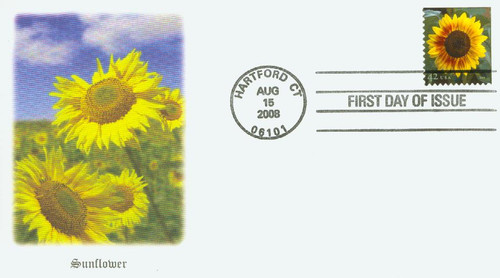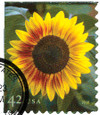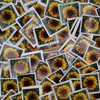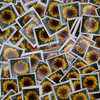
# 4347 - 2008 42c Sunflower
U.S. #4347
Sunflower
Issue Date: August 15, 2008
City: Hartford, CT
Native to the Americas, the sunflower (Helianthus annuus) is a tall annual plant with a large flowering head. Sunflowers often grow to heights of eight to twelve feet. Shorter varieties are frequently used for cut flower arrangements, while large varieties provide brilliant splashes of color in outdoor gardens.
Commonly referred to as a flower, the sunflower head is actually made up of many smaller flowers. The sterile outer flowers, or ray florets, may be a variety of bright colors. The inner disc florets mature into the fruit of the plant, which are generally called sunflower seeds.
Immature sunflower plants are heliotropic, or sun-tracking. After following the sun from east to west, sunflowers return to face the east at dusk. The movement is performed by a flexible segment of the stem below the bud. As the plant matures, the stem stiffens and blooms appear.
Native Americans were the first to cultivate sunflowers. In addition to attracting birds and wildlife, sunflowers are a source of seeds for snacking, oil that may be used for cooking, and livestock feed.
The sunflower, which is Kansas’ state flower, thrives in temperate regions across the United States. The 2008 42¢ First Class stamp pictures a sunflower in Santa Fe, New Mexico.
U.S. #4347
Sunflower
Issue Date: August 15, 2008
City: Hartford, CT
Native to the Americas, the sunflower (Helianthus annuus) is a tall annual plant with a large flowering head. Sunflowers often grow to heights of eight to twelve feet. Shorter varieties are frequently used for cut flower arrangements, while large varieties provide brilliant splashes of color in outdoor gardens.
Commonly referred to as a flower, the sunflower head is actually made up of many smaller flowers. The sterile outer flowers, or ray florets, may be a variety of bright colors. The inner disc florets mature into the fruit of the plant, which are generally called sunflower seeds.
Immature sunflower plants are heliotropic, or sun-tracking. After following the sun from east to west, sunflowers return to face the east at dusk. The movement is performed by a flexible segment of the stem below the bud. As the plant matures, the stem stiffens and blooms appear.
Native Americans were the first to cultivate sunflowers. In addition to attracting birds and wildlife, sunflowers are a source of seeds for snacking, oil that may be used for cooking, and livestock feed.
The sunflower, which is Kansas’ state flower, thrives in temperate regions across the United States. The 2008 42¢ First Class stamp pictures a sunflower in Santa Fe, New Mexico.













